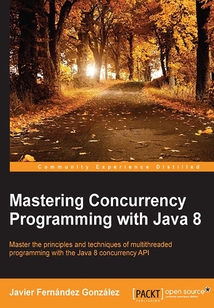目錄(72章)
倒序
- 封面
- 版權信息
- Credits
- About the Author
- About the Reviewers
- www.PacktPub.com
- Preface
- Chapter 1. The First Step – Concurrency Design Principles
- Basic concurrency concepts
- Possible problems in concurrent applications
- A methodology to design concurrent algorithms
- Java concurrency API
- Concurrency design patterns
- The Java memory model
- Tips and tricks to design concurrent algorithms
- Summary
- Chapter 2. Managing Lots of Threads – Executors
- An introduction to executors
- First example – the k-nearest neighbors algorithm
- The second example – concurrency in a client/server environment
- Comparing the two solutions
- Other methods of interest
- Summary
- Chapter 3. Getting the Maximum from Executors
- Advanced characteristics of executors
- The first example – an advanced server application
- The second example – executing periodic tasks
- Additional information about executors
- Summary
- Chapter 4. Getting Data from the Tasks – The Callable and Future Interfaces
- Introducing the Callable and Future interfaces
- First example – a best-matching algorithm for words
- The second example – creating an inverted index for a collection of documents
- Summary
- Chapter 5. Running Tasks Divided into Phases – The Phaser Class
- An introduction to the Phaser class
- First example – a keyword extraction algorithm
- The second example – a genetic algorithm
- Summary
- Chapter 6. Optimizing Divide and Conquer Solutions – The Fork/Join Framework
- An introduction to the Fork/Join framework
- The first example – the k-means clustering algorithm
- The second example – a data filtering algorithm
- The third example – the merge sort algorithm
- Other methods of the Fork/Join framework
- Summary
- Chapter 7. Processing Massive Datasets with Parallel Streams – The Map and Reduce Model
- An introduction to streams
- The first example – a numerical summarization application
- The second example – an information retrieval search tool
- Summary
- Chapter 8. Processing Massive Datasets with Parallel Streams – The Map and Collect Model
- Using streams to collect data
- The first example – searching data without an index
- The second example – a recommendation system
- The third example – common contacts in a social network
- Summary
- Chapter 9. Diving into Concurrent Data Structures and Synchronization Utilities
- Concurrent data structures
- Synchronization mechanisms
- Summary
- Chapter 10. Integration of Fragments and Implementation of Alternatives
- Big-block synchronization mechanisms
- An example of a document clustering application
- Implementation of alternatives with concurrent programming
- Summary
- Chapter 11. Testing and Monitoring Concurrent Applications
- Monitoring concurrency objects
- Monitoring concurrency applications
- Testing concurrency applications
- Summary
- Index 更新時間:2021-07-16 12:55:15
推薦閱讀
- Java逍遙游記
- GitLab Cookbook
- Visual C++實例精通
- Python網絡爬蟲從入門到實踐(第2版)
- Magento 2 Development Cookbook
- C語言程序設計實驗指導 (第2版)
- Learning OpenStack Networking(Neutron)(Second Edition)
- 深度學習:Java語言實現
- Java高并發核心編程(卷1):NIO、Netty、Redis、ZooKeeper
- 零基礎學C語言第2版
- Clojure High Performance Programming(Second Edition)
- Node.js應用開發
- PostgreSQL 12 High Availability Cookbook
- Getting Started with RethinkDB
- Java EE 程序設計
- Neo4j Graph Data Modeling
- Django 3 Web應用開發從零開始學(視頻教學版)
- Multithreading with C# Cookbook(Second Edition)
- Mastering Python Scientific Computing
- Mastering CSS
- 圖形圖像設計與制作(第二版)
- Harbor權威指南:容器鏡像、Helm Chart等云原生制品的管理與實踐
- Learning ArcGIS Runtime SDK for .NET
- Data Lake Development with Big Data
- Android Studio 2 Essentials(Second Edition)
- 算法競賽寶典(第三部):基礎數據結構
- C語言程序設計項目式教程(在線實驗+在線自測 )
- ROS機器人編程零基礎入門與實踐
- React+Node.js開發實戰:從入門到項目上線
- Oracle Database 12c Backup and Recovery Survival Guide


